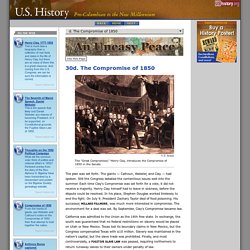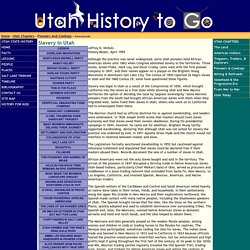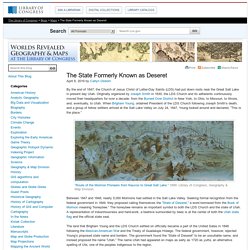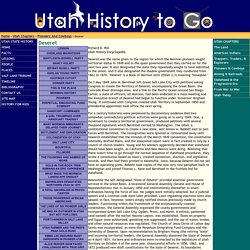

The Compromise of 1850. U.S.

Senate The "Great Compromiser," Henry Clay, introduces the Compromise of 1850 in the Senate. The plan was set forth. The giants — Calhoun, Webster, and Clay — had spoken. Compromise of 1850 - Facts & Summary. The compromise was the last major involvement in national affairs of Senators Henry Clay of Kentucky, Daniel Webster of Massachusetts, and John C.

Calhoun of South Carolina, all of whom had had exceptional careers in the Senate. Calhoun died the same year, and Clay and Webster two years later. At first, Clay introduced an omnibus bill covering these measures. Calhoun attacked the plan and demanded that the North cease its attempts to limit slavery. By backing Clay in a speech delivered on March 7, Webster antagonized his onetime abolitionist supporters.
Living History: Slaves arrived in Utah with Brigham Young - The Salt Lake Tribune. Three of the names are set just a little apart from the others under the subhead: Colored Servants.

These are Green Flake, Oscar Crosby and Hark Lay. Crosby and Lay accompanied their Mormon masters to California to establish a colony in San Bernardino in 1851. California law prohibited slavery and it is assumed the two became freemen. Green Flake has a deeper history in Utah. Pioneers and Cowboys. Jeffrey D.

Nichols History Blazer, April 1995 Although the practice was never widespread, some Utah pioneers held African-American slaves until 1862 when Congress abolished slavery in the territories. Three slaves, Green Flake, Hark Lay, and Oscar Crosby, came west with the first pioneer company in 1847, and their names appear on a plaque on the Brigham Young Monument in downtown Salt Lake City. The area of Deseret started huge, got smaller as it became Utah.
Editor's note: Imagine the "State of Deseret.

" Brigham Young and the Mormon pioneers who founded Great Salt Lake City 160-plus years ago did just that. Their vision encompassed a vast swath of today's American West. 3 Maps. Worlds Revealed: Geography & Maps at The Library Of Congress. By the end of 1847, the Church of Jesus Christ of Latter-Day Saints (LDS) had put down roots near the Great Salt Lake in present day Utah.

Originally organized by Joseph Smith in 1830, the LDS Church and its adherents continuously moved their headquarters for over a decade: from the Burned Over District in New York, to Ohio, to Missouri, to Illinois, and, eventually, to Utah. When Brigham Young, ordained President of the LDS Church following Joseph Smith’s death, and a group of fellow settlers arrived at the Salt Lake Valley on July 24, 1847, Young looked around and declared, “This is the place.” Between 1847 and 1848, nearly 5,000 Mormons had settled in the Salt Lake Valley. Seeking formal recognition from the federal government in 1849, they proposed calling themselves the “State of Deseret,” a word borrowed from the Book of Mormon meaning “honeybee.”
Pioneers and Cowboys. Richard D.

Poll Utah History Encyclopedia Deseret was the name given to the region for which the Mormon pioneers sought territorial status in 1849 and to the quasi government that they carried on for the next two year.